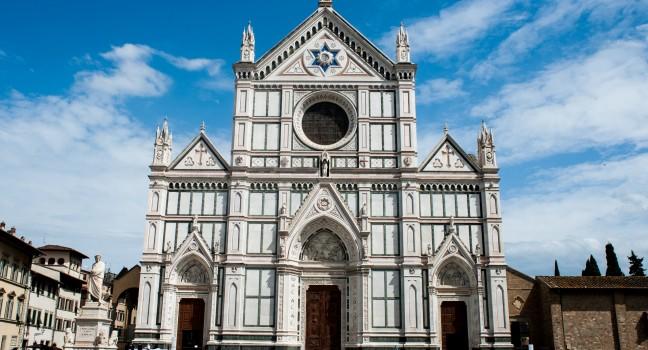Santa Croce

As a burial place, this Gothic church (whose facade dates from the 19th century) contains the skeletons of many Renaissance celebrities. The tomb of Michelangelo is on the right at the front of the basilica, a location he is said to have chosen so that the first thing he would see on Judgment Day, when the graves of the dead fly open, would be Brunelleschi's dome through Santa Croce's open doors. The tomb of Galileo Galilei (1564–1642) is on the left wall. He was not granted a Christian burial until 100 years after his death because of his controversial contention that Earth was not the center of the universe. The tomb of Niccolò Machiavelli (1469–1527), the political theoretician whose brutally pragmatic philosophy so influenced the Medici, is halfway down the nave on the right. The grave of Lorenzo Ghiberti, creator of the Baptistery doors, is halfway down the nave on the left. Composer Gioachino Rossini (1792–1868) is buried at the end of the nave on the right. The monument to Dante Alighieri (1265–1321), the greatest Italian poet, is a memorial rather than a tomb (he is buried in Ravenna); it's on the right wall near the tomb of Michelangelo.
The complex's collection of art is by far the most important of any church in Florence. The most famous works are the Giotto frescoes in the two chapels immediately to the right of the high altar. They illustrate scenes from the lives of St. John the Evangelist and St. John the Baptist (in the right-hand chapel), as well as those from the life of St. Francis (in the left-hand chapel). Time has not been kind to these frescoes; through the centuries, wall tombs were placed in the middle of them, they were whitewashed and plastered over, and they suffered a clumsy 19th-century restoration. But the reality that Giotto introduced into painting can still be seen. He did not paint beautifully stylized religious icons, as the Byzantine style that preceded him prescribed. Instead, he painted drama—St. Francis surrounded by grieving friars at the very moment of his death. This was a radical shift in emphasis: before Giotto, painting's role was to symbolize the attributes of God; after him, it was to imitate life. His work is indeed primitive compared with later painting, but in the early 14th century it caused a sensation that was not equaled for another 100 years. He was, for his time, the equal of both Masaccio and Michelangelo.
Other highlights are Donatello's Annunciation, a moving expression of surprise (on the right wall two-thirds of the way down the nave); 14th-century frescoes by Taddeo Gaddi (circa 1300–66) illustrating scenes from the life of the Virgin Mary, clearly showing the influence of Giotto (in the chapel at the end of the right transept); and Donatello's Crucifix, criticized by Brunelleschi for making Christ look like a peasant (in the chapel at the end of the left transept). Outside the church proper, in the Museo dell'Opera di Santa Croce off the cloister, is the 13th-century Crucifix by Cimabue (circa 1240–1302), badly damaged by the flood of 1966. A model of architectural geometry, the Cappella Pazzi, at the end of the cloister, is the work of Brunelleschi.



